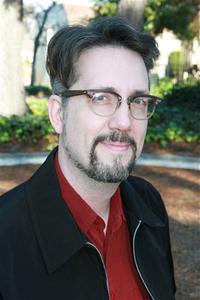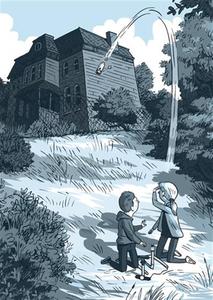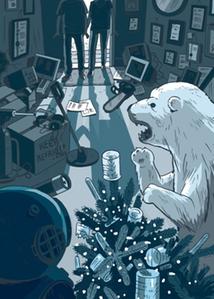When Quirk Books publisher Jason Rekulak approached Steve Hockensmith with the idea of creating a MacGyver-style series for young readers, Hockensmith readily agreed. The next challenge was to find a science-savvy collaborator who could supply and test the experiments. After scouring the Internet, Hockensmith found "Science Bob" Pflugfelder, an elementary school science teacher who has appeared on Jimmy Kimmel Live, The Dr. Oz Show and Live With Kelly & Michael. Here they discuss the yin and yang of their unusual collaboration.

|
|
| Steve Hockensmith | |
This project makes for a unique partnership. How did you work together?
Steve Hockensmith: We've never met, but it's all very amiable on our conference calls.
Bob Pflugfelder: This is the amazing thing about 21st-century writing: the entire first book is finished, and we've never all [Steve, Jason and Bob] met together.
SH: It's been all conference calls and e-mails. Before Bob does the final instruction version, he'll send detailed pdfs of how the experiment is going to be put together, what it's going to do, how it's going to act. Bob has also sent us YouTube clips of him doing these things so we can see how it works, and fool people into thinking we're in the lab together.
BP: People think we're like Frankenstein and Igor.
SH: Wait a second, who's Frankenstein and who's Igor? I can picture you cackling while I prance around playing with electrodes.

|
|
| "Science Bob" Pflugfelder | |
Steve, do you sometimes fit the narrative to a great experiment or, Bob, do you suggest a plot twist to accommodate one?
SH: For the second book, Nick and Tesla's Robot Army Rampage, I had a plot I was working on that I thought was pretty good. We were locked into the title, and I thought, "I've got to have a robot army, and I don't know how to do it without taking Nick and Tesla out of the neighborhood." Bob said, "What about this idea?" His solution would keep them in the neighborhood, and also in the reality we'd established in the first book. I'd spent two weeks on that plot. If I was going to get huffy, that would have been the moment. All of that to say, I'm a wonderful fellow, so when Bob had a better idea, I was all for it. It has yet to go another way--like me having an idea for a pie launcher.
BP: I think that's what defines a series when you're getting a series started. How tied are you to reality and plausibility? We wanted readers to buy into the reality but at the same time to take them on adventures they couldn't maybe go on on their own.
Bob, when you spoke on the Middle Grade Buzz Panel at Book Expo this past spring, you said that you liked the Hardy Boys and My Side of the Mountain as a child. Did you say yes to this series because it has a little something for both of those audiences?
BP: I'm one of those kids who would have flipped through and seen the instructions for the projects in this book and picked it up. I'm the kid who read the Hardy Boys and then would go and make the projects.
SH: I would have been the kind of kid who'd read the story and enjoy it, and my eyes would glaze over when the projects came along. I'm not a hands-on building crafts kind of guy. Any time my kids get a gift that requires it to be put together, you'll hear unfriendly language and it will take five hours to put it together.
 BP: I think it will be interesting to see what percentage of the kids actually build the projects because that attracts them, and what percentage enjoys the storyline. People will say, "What's the book about?" I'll tell them, and add that we'll have the instructions for the projects in the book. When I tell librarians that, they light up and say, "I have a kid that will really like that."
BP: I think it will be interesting to see what percentage of the kids actually build the projects because that attracts them, and what percentage enjoys the storyline. People will say, "What's the book about?" I'll tell them, and add that we'll have the instructions for the projects in the book. When I tell librarians that, they light up and say, "I have a kid that will really like that."
SH: The book appeals to two different sets of kids: the kids that will just enjoy a funny mystery, and then the kids who love projects and science. Hopefully both groups would get their money's worth and time's worth out of it.
So, Steve, did you actually do the experiments? Your narrative describes very specifically what happens as a result of them.
SH: Shocking admission: Bob builds the experiments, of course. Jason and the Quirk folks test them. I use my imagination and often watch Bob's videos. I'm far too lazy.
BP: We had to figure out how much technology could be involved. We decided that the experiments couldn't involve soldering. It knocked out some projects, but we've gotten feedback that people are building these things! People from the Facebook page are posting what they're doing.
SH: Now that I'm halfway through the third book, we may have to revisit the soldering rule. We'll talk about that later.
Bob, have you found it challenging to come up with projects that both fit the narrative and also require only ready "ingredients"?
BP: I have to admit that it has been trickier than I thought it would be--most of the projects have to do something. When you say, "Build something that will accomplish a mission that fits into the story line," it's challenging. A lot of times it's too simple or too complicated, or I'll find an idea and I'll discover the materials are too hard to find. We had an idea for a homemade periscope. But you can't find the right mirror easily. We wanted kids to be able to use things that are universally available, and that they'd want to build them because they're cool.
 Tell us more about Uncle Newt--what an interesting character.
Tell us more about Uncle Newt--what an interesting character.
SH: Originally, it was going to be like the twins were going to live with Q from the James Bond movies. Newt would build contraptions for spies. We decided it wouldn't be so big--that the uncle had to be more down-to-earth, someone you'd find in a suburban neighborhood. Once we went in that direction, he was more of a mad scientist blended with an absent-minded professor.
I love writing that guy. He's so eccentric and yet so smart. These books celebrate smartness.
Do you think there's a new wave of interest in science, with the current wave of maker fairs and the like?
BP: If you go back to five years ago, the science you would have seen on television would have all been science fiction, especially for kids. Now we have those and we also have programs like The Big Bang Theory, where science does matter, and they discuss things like string theory and Schrödinger's Cat, and the maker movement is growing. The timing of this book is especially keen. I think kids are finding reasons to build things and problem solve, and if we can find ways for that project to have a connection to a story they like, that will be powerful.
Nick and Tesla are not geniuses; they're problem-solving kids. A situation comes up and they say, Can we build something that can help us with that? Uncle Newt, who we think is a genius, is not a resource for them other than the stuff he has around the house. They're resourceful kids with fourth-grade knowledge. --Jennifer M. Brown

